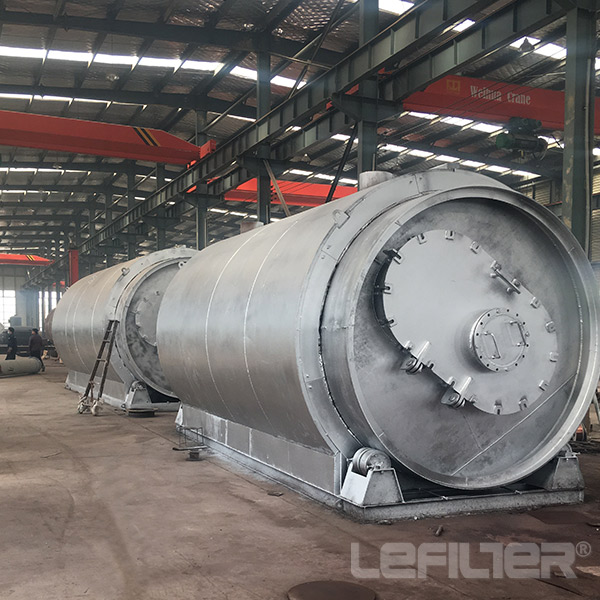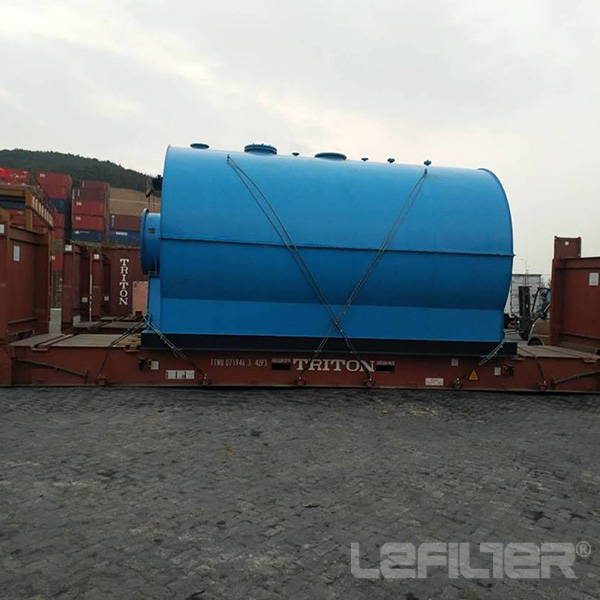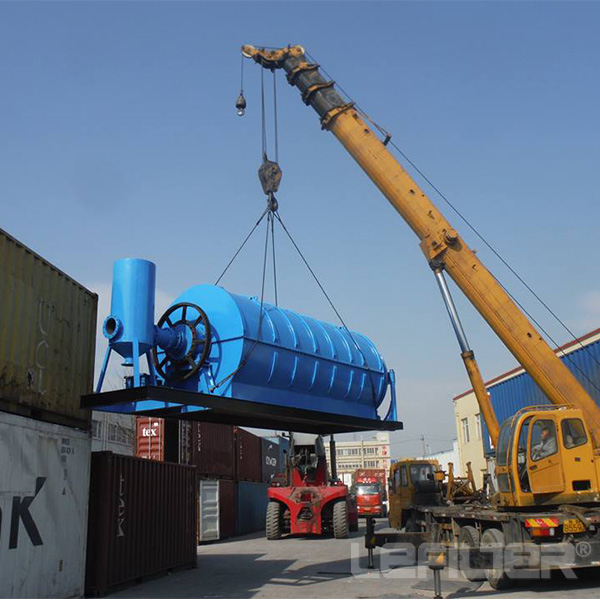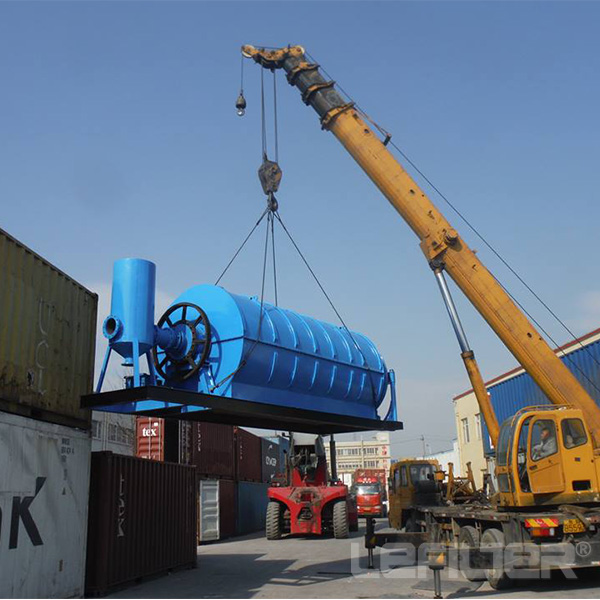
waste plastic pyrolysis machine
Introduction:I The Waste tire pyrolysis plant process flow: 1. The raw materials are directly loaded into the cracking kettle, heated by catalysis, and the oil vapor is distilled off. The oil and gas passes through the steam drum to release pressure and
We're here to help:
Easy ways to get the answers you need.
Product parameter:
I The Waste tire pyrolysis plant process flow:
1. The raw materials are directly loaded into the cracking kettle, heated by catalysis, and the oil vapor is distilled off. The oil and gas passes through the steam drum to release pressure and enter the condenser.
2. The liquefiable part is condensed into fuel oil, the non-liquefiable part is the synchronized gas through the safety device water seal, the gas system, a part of the combustible gas is taken into the combustion chamber to burn off, and the other part of the extra flammable gas is introduced. Exhaust gas combustion chamber burns or collects.
3. The soot produced during the entire combustion process passes through the desulphurization and dust removal system of soot to remove acid gas and dust, and is discharged after reaching the national environmental protection standards. The pyrolysis vessel is cooled and carbon black is released.
II The characteristics of Waste tire pyrolysis plant
1, security
The main equipment safety. In the production process, the main components of the non-liquefiable exhaust gas are C1 to C4 alkanes, and direct combustion has certain risks. In our current production process, before it is burned as a fuel, it is first sealed by the first safety device and then passed through a second safety device gas nozzle so that it can be safely produced.
2, environmental protection
Treatment of the three wastes in the production process.
1) Exhaust gas
Through two safety device water seals and gas nozzles are fully burned, which not only eliminates the pollution of exhaust gas, but also saves a lot of fuel; the use of water impact spray desulphurization dust collector in soot discharge, soot emissions can reach the atmospheric pollutants of GB13271-2001 boiler Emission Standards.
2) Waste solution
During the processing of oil products, some weakly acidic wastewater will be produced (about 50 kg of wastewater will be produced per ton of oil produced, and the amount will be small and easy to handle). After neutralization by adding a weak alkali solution, the neutral wastewater is subjected to three-stage filtration to achieve detoxification, and is discharged to a dedicated evaporation processor (whose heat source uses the waste heat of the main processor) to evaporate.
3) Waste solids
In waste tires, the waste rubber is thermally cracked by the catalyst, and the remaining residue is carbon black, and no waste solids exist.
III Waste tire pyrolysis plant product usage
1.Pyrolysis oil
1) It can be used directly as a substitute for fuel for industrial or boiler heating, eg cement plants, steel mills, glass plants, etc.;
2) Can be refined into diesel for diesel fuel and power plants, agricultural machinery, etc. Note: The oil that is directly cracked by the tire is gross oil and can be used directly as industrial fuel. For refinery diesel, a set of refining equipment is also required.
Waste Rubber Refinery Equipment Final Product: Pyrolysis Oil Use
2. Carbon black
1) It can be used for industrial heating by pressure ball combustion. Its combustion calorific value is equivalent to that of coal, and can be directly used instead of coal;
2) The toner can be refined into different standards for additives such as paint pigments and rubber products.
Waste Rubber Refinery Equipment Final Product: Carbon Black Use
3. Steel wire
1) Sold to waste recycling station
2) Sell directly to steel smelters and re-smelt
IV Technical parameters
V . Application
1. Metallurgy: Filtration of the hydraulic system of rolling mills and continuous casters and the filtration of various lubrication equipment.
2. Petrochemical: Separation and recovery of products and intermediate products in the process of oil refining, chemical production, oil field injection well water and natural gas in addition to particle filtration.
3, textile: Polyester melt in the drawing process of purification and uniform filtration, air compressor protection and filtration, degreasing of compressed gas in addition to water.
4. Electronics and pharmaceuticals: pretreatment filtration of reverse osmosis water, deionized water, and pretreatment filtration of detergent and glucose.
5, thermal power and nuclear power: gas turbine, boiler lubrication system, speed control system, bypass control system oil purification, feed pump, fan and dust removal system.
Contact Information:
Bella / Overseas Manager
Email:sales06@xxldlq.com
Mob :008615565444640 (wechat,whats app)
1. The raw materials are directly loaded into the cracking kettle, heated by catalysis, and the oil vapor is distilled off. The oil and gas passes through the steam drum to release pressure and enter the condenser.
2. The liquefiable part is condensed into fuel oil, the non-liquefiable part is the synchronized gas through the safety device water seal, the gas system, a part of the combustible gas is taken into the combustion chamber to burn off, and the other part of the extra flammable gas is introduced. Exhaust gas combustion chamber burns or collects.
3. The soot produced during the entire combustion process passes through the desulphurization and dust removal system of soot to remove acid gas and dust, and is discharged after reaching the national environmental protection standards. The pyrolysis vessel is cooled and carbon black is released.
II The characteristics of Waste tire pyrolysis plant
1, security
The main equipment safety. In the production process, the main components of the non-liquefiable exhaust gas are C1 to C4 alkanes, and direct combustion has certain risks. In our current production process, before it is burned as a fuel, it is first sealed by the first safety device and then passed through a second safety device gas nozzle so that it can be safely produced.
2, environmental protection
Treatment of the three wastes in the production process.
1) Exhaust gas
Through two safety device water seals and gas nozzles are fully burned, which not only eliminates the pollution of exhaust gas, but also saves a lot of fuel; the use of water impact spray desulphurization dust collector in soot discharge, soot emissions can reach the atmospheric pollutants of GB13271-2001 boiler Emission Standards.
2) Waste solution
During the processing of oil products, some weakly acidic wastewater will be produced (about 50 kg of wastewater will be produced per ton of oil produced, and the amount will be small and easy to handle). After neutralization by adding a weak alkali solution, the neutral wastewater is subjected to three-stage filtration to achieve detoxification, and is discharged to a dedicated evaporation processor (whose heat source uses the waste heat of the main processor) to evaporate.
3) Waste solids
In waste tires, the waste rubber is thermally cracked by the catalyst, and the remaining residue is carbon black, and no waste solids exist.
III Waste tire pyrolysis plant product usage
1.Pyrolysis oil
1) It can be used directly as a substitute for fuel for industrial or boiler heating, eg cement plants, steel mills, glass plants, etc.;
2) Can be refined into diesel for diesel fuel and power plants, agricultural machinery, etc. Note: The oil that is directly cracked by the tire is gross oil and can be used directly as industrial fuel. For refinery diesel, a set of refining equipment is also required.
Waste Rubber Refinery Equipment Final Product: Pyrolysis Oil Use
2. Carbon black
1) It can be used for industrial heating by pressure ball combustion. Its combustion calorific value is equivalent to that of coal, and can be directly used instead of coal;
2) The toner can be refined into different standards for additives such as paint pigments and rubber products.
Waste Rubber Refinery Equipment Final Product: Carbon Black Use
3. Steel wire
1) Sold to waste recycling station
2) Sell directly to steel smelters and re-smelt
IV Technical parameters
| Items | Contents | ||||||
| Input-Raw Materials | Waste tire/rubber/plastic/Medical waste/municipal solid waste/waste organic glass | ||||||
| Final products | Fuel oil, N220, N330 carbon black, steel wire, flammable gas. | ||||||
| P/N | HJA-7 | HJA-8 | HJA-9 | HJA-10 | |||
| Capacity/24h | 6-7Ton/Batch | 8 -9Ton/Batch | 10-11Ton/Batch | 12-13Ton/Batch | |||
| Oil production(T)/24h | 2.7-3.2 | 3.6-4 | 4.5-5 | 5.4-5.8 | |||
| Power | 4KW | 4.5KW | 5.5KW | 7.5KW | |||
| Cooling water(T/h) | 4 | 5 | 6 | 8 | |||
| Rotate speed(r/min) | 0.4 | ||||||
| Heating type | Direct heat | ||||||
| Cooling type | Water-cooled | ||||||
| Noise(dB) | ≦85 | ||||||
| Operating | Intermittent | ||||||
| Driving mode | Internal gear | External gear | |||||
| Reactor material | Q345R/Q245R/310S+Boiler plate/Stainless steel | ||||||
| Structure | Horizontal rotation | ||||||
| Host weight(T) | 20 | 23 | 26 | 28 | |||
| Reactor size(mm) | Ø2200*5100 | Ø2200*6000 | Ø2600*6600 | Ø2800*6600 | |||
| Space needed | 200-300 square meters (Width:10m, Length:20m-30m) | ||||||
| Combustion value | 35-50m3 | ||||||
| Note |
We supply customized plant,we need some basic information: What kind of raw material to recycle? Tires for car, truck, motorbike... Plastic of PVC,PE, PP,PS,ABS,bags,acrylic, rubber, medical waste, oil sludge industrial waste material... What capacity do you need to recycle per day? (Ton) What fuel do you use? Coal,gas,wood... |
||||||
| Final Products | Yield | Application |
| Fuel Oil | 45%-55% |
1. Heating material:sell to cement factory, glass factory, ceramic factory, electric power factory, steel making factory, boiler factory, etc. 2. Used for heavy oil generator for electricity generation. 3. Deep process it into diesel oil then can be used in cars,trucks, tractors, etc. |
| Carbon Black | 30%-35% |
1. Make it into pellet or briquette as heating material. 2. Make it into N220, N330, N550 or N660 which is widely used in tire making industry. 3. Make it into plastic grains then sold to plastic industry. |
| Steel Wire | 30%-35% |
1. Sell it to iron and steel factory directly. 2. Sell it to steel distributors. |
| Flammable Gas | 8%-10% |
1. Recycled into furnace to heat reactor instead of coal/wood/oil/natural gas. 2. Store it then supply the pyrolysis equipment heating,it’s recycling. |
V . Application
1. Metallurgy: Filtration of the hydraulic system of rolling mills and continuous casters and the filtration of various lubrication equipment.
2. Petrochemical: Separation and recovery of products and intermediate products in the process of oil refining, chemical production, oil field injection well water and natural gas in addition to particle filtration.
3, textile: Polyester melt in the drawing process of purification and uniform filtration, air compressor protection and filtration, degreasing of compressed gas in addition to water.
4. Electronics and pharmaceuticals: pretreatment filtration of reverse osmosis water, deionized water, and pretreatment filtration of detergent and glucose.
5, thermal power and nuclear power: gas turbine, boiler lubrication system, speed control system, bypass control system oil purification, feed pump, fan and dust removal system.
Contact Information:
Bella / Overseas Manager
Email:sales06@xxldlq.com
Mob :008615565444640 (wechat,whats app)
Please fill in your procurement needs and contact information










